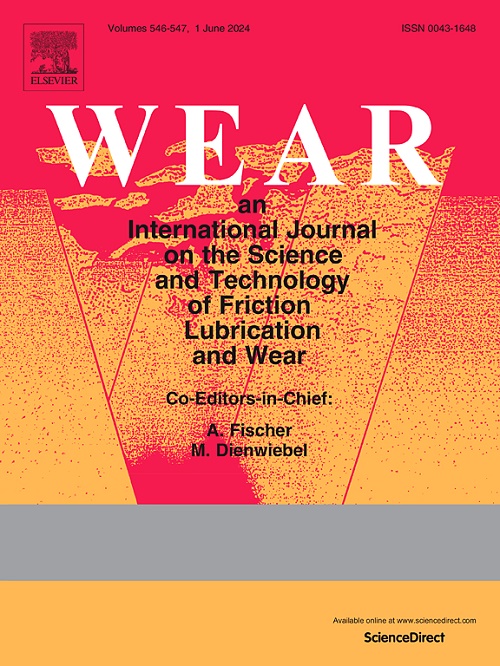Optimal wear resistance of particle-reinforced heterostructure high-entropy alloy FeMnCoCr by strength–ductility matching and TRIP effect
IF 5.3
1区 工程技术
Q1 ENGINEERING, MECHANICAL
引用次数: 0
Abstract
Sliding wear results indicated that although the wear rates increased with a decrease in the hardness of the samples, the wear rate of the strength–ductility matching sample with a recrystallization volume fraction of 75 % (V75) abnormally decreased. High strength and low dislocation density in the strength–ductility matching sample were conducive to the formation of the hexagonal close-packed (HCP) phase. However, the high dislocation density in the sample with a low recrystallization volume fraction of 26 % (V26) and the low stress generated during wear testing due to the low strength of the sample with a high recrystallization volume fraction of 87 % (V87) were not conducive to the production of the HCP phase. The thickness of the HCP phase in the subsurface of V75 was 21 μm, which was 2.3 times that of V87 (9 μm) after wear. The generation of the HCP phase not only improved the work-hardening ability of the sample but also led to grain refinement, which was beneficial for acquiring a thicker ultrafine grain layer. The inferior plasticity of V26 and the deformability due to the low strength of V87 were not favorable for the formation of a stable dynamic oxide film. The higher strength resisted deformation, and outstanding ductility reduced the probability of crack generation in V75, which demonstrated a thicker deformation layer and a complete dynamic oxide film after wear, conducive to reducing the wear rate. The proposed bimodal-structural material design strategy provides an effective method for designing materials with high wear resistances.
通过强度-电导率匹配和 TRIP 效应优化颗粒强化异质结构高熵合金铁锰钴铬的耐磨性
滑动磨损结果表明,虽然磨损率随着样品硬度的降低而增加,但再结晶体积分数为 75% (V75)的强度-电导率匹配样品的磨损率却异常降低。强度-电导率匹配样品的高强度和低位错密度有利于六方紧密堆积相(HCP)的形成。然而,再结晶体积分数低至 26% (V26) 的样品位错密度高,再结晶体积分数高至 87% (V87) 的样品强度低,在磨损测试中产生的应力小,不利于 HCP 相的形成。磨损后,V75 表面下的 HCP 相厚度为 21 μm,是 V87(9 μm)的 2.3 倍。HCP 相的生成不仅提高了试样的加工硬化能力,还导致了晶粒细化,有利于获得更厚的超细晶粒层。V26 的塑性较差,V87 的强度较低,容易变形,不利于形成稳定的动态氧化膜。而 V75 具有较高的抗变形强度和出色的延展性,降低了裂纹产生的概率,在磨损后形成了较厚的变形层和完整的动态氧化膜,有利于降低磨损率。所提出的双模结构材料设计策略为设计高耐磨性材料提供了一种有效的方法。
本文章由计算机程序翻译,如有差异,请以英文原文为准。
求助全文
约1分钟内获得全文
求助全文
来源期刊

Wear
工程技术-材料科学:综合
CiteScore
8.80
自引率
8.00%
发文量
280
审稿时长
47 days
期刊介绍:
Wear journal is dedicated to the advancement of basic and applied knowledge concerning the nature of wear of materials. Broadly, topics of interest range from development of fundamental understanding of the mechanisms of wear to innovative solutions to practical engineering problems. Authors of experimental studies are expected to comment on the repeatability of the data, and whenever possible, conduct multiple measurements under similar testing conditions. Further, Wear embraces the highest standards of professional ethics, and the detection of matching content, either in written or graphical form, from other publications by the current authors or by others, may result in rejection.
 求助内容:
求助内容: 应助结果提醒方式:
应助结果提醒方式:


